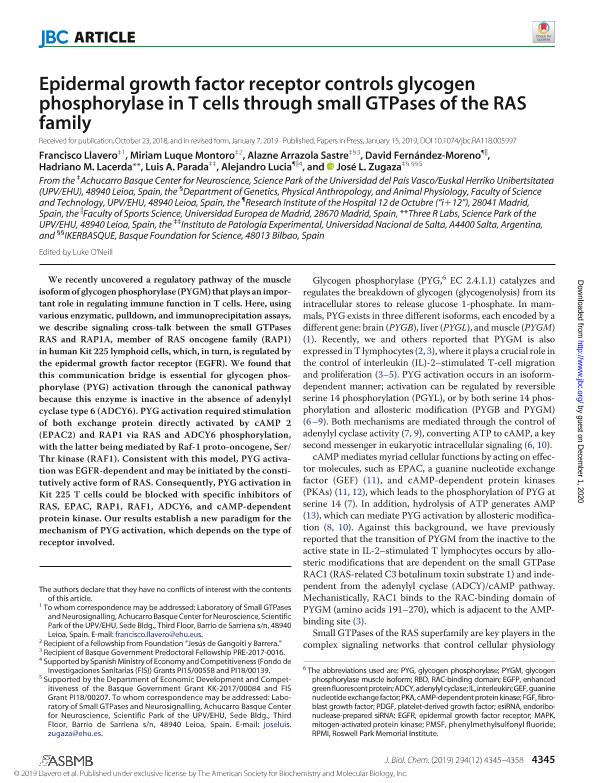Artículo
Epidermal growth factor receptor controls glycogen phosphorylase in T cells through small GTPases of the RAS family
Llavero, Francisco; Montoro, Miriam Luque; Sastre, Alazne Arrazola; Fernández Moreno, David; Lacerda, Hadriano M.; Parada, Luis Antonio ; Lucia, Alejandro
; Lucia, Alejandro ; Zugaza, José L.
; Zugaza, José L.
 ; Lucia, Alejandro
; Lucia, Alejandro ; Zugaza, José L.
; Zugaza, José L.
Fecha de publicación:
22/03/2019
Editorial:
American Society for Biochemistry and Molecular Biology
Revista:
Journal of Biological Chemistry (online)
ISSN:
0021-9258
Idioma:
Inglés
Tipo de recurso:
Artículo publicado
Clasificación temática:
Resumen
We recently uncovered a regulatory pathway of the muscle isoform of glycogen phosphorylase (PYGM) that plays an important role in regulating immune function in T cells. Here, using various enzymatic, pulldown, and immunoprecipitation assays, we describe signaling cross-talk between the small GTPases RAS and RAP1A, member of RAS oncogene family (RAP1) in human Kit 225 lymphoid cells, which, in turn, is regulated by the epidermal growth factor receptor (EGFR). We found that this communication bridge is essential for glycogen phosphorylase (PYG) activation through the canonical pathway because this enzyme is inactive in the absence of adenylyl cyclase type 6 (ADCY6). PYG activation required stimulation of both exchange protein directly activated by cAMP 2 (EPAC2) and RAP1 via RAS and ADCY6 phosphorylation, with the latter being mediated by Raf-1 proto-oncogene, Ser/ Thr kinase (RAF1). Consistent with this model, PYG activation was EGFR-dependent and may be initiated by the constitutively active form of RAS. Consequently, PYG activation in Kit 225 T cells could be blocked with specific inhibitors of RAS, EPAC, RAP1, RAF1, ADCY6, and cAMP-dependent protein kinase. Our results establish a new paradigm for the mechanism of PYG activation, which depends on the type of receptor involved.
Archivos asociados
Licencia
Identificadores
Colecciones
Articulos(IPE)
Articulos de INST.DE PATOLOGIA EXPERIMENTAL
Articulos de INST.DE PATOLOGIA EXPERIMENTAL
Citación
Llavero, Francisco; Montoro, Miriam Luque; Sastre, Alazne Arrazola; Fernández Moreno, David; Lacerda, Hadriano M.; et al.; Epidermal growth factor receptor controls glycogen phosphorylase in T cells through small GTPases of the RAS family; American Society for Biochemistry and Molecular Biology; Journal of Biological Chemistry (online); 294; 12; 22-3-2019; 4345-4358
Compartir
Altmétricas



